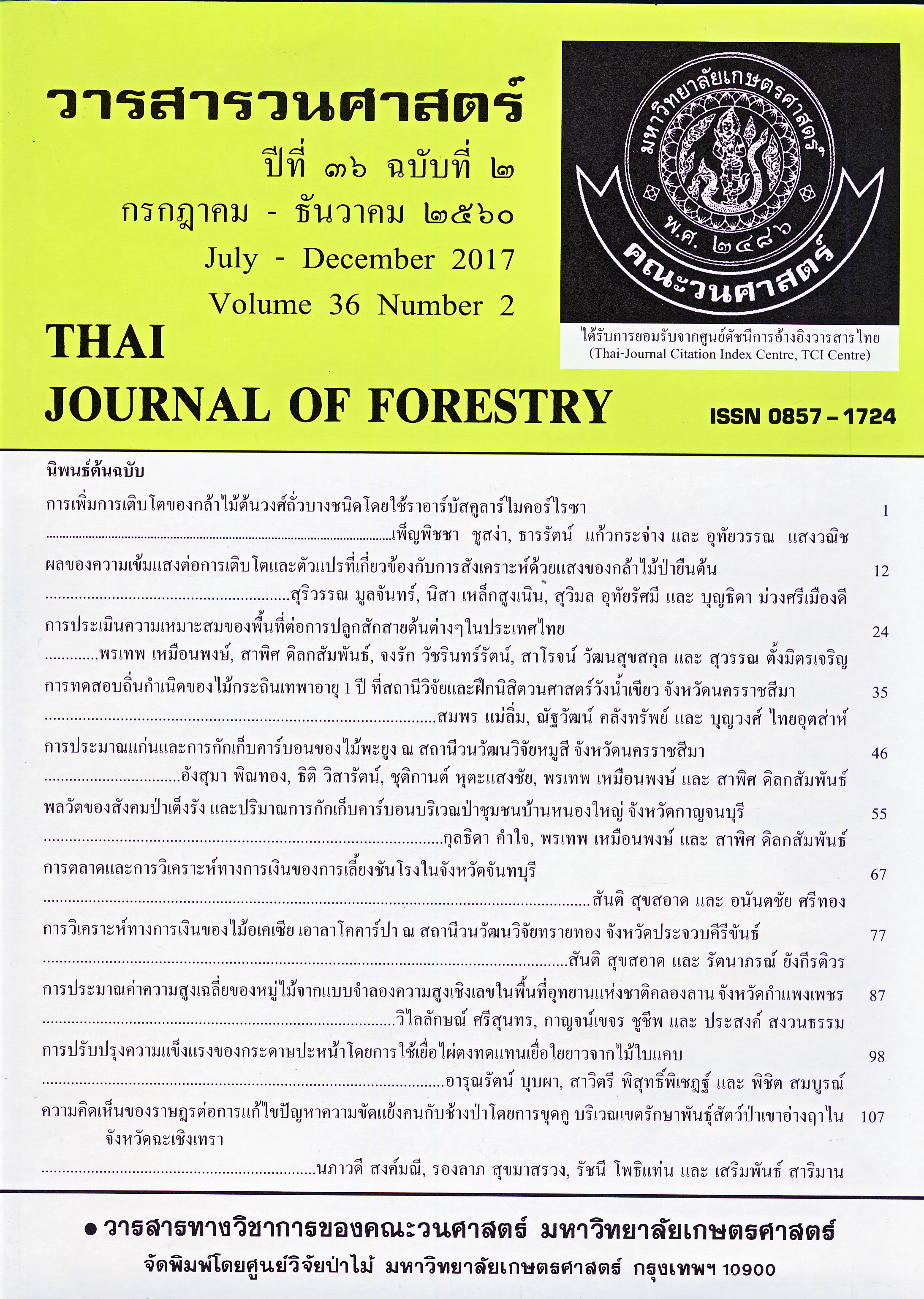ผลของความเข้มแสงต่อการเติบโตและตัวแปรที่เกี่ยวข้องกับการสังเคราะห์ด้วยแสง ของกล้าไม้ป่ายืนต้น
Main Article Content
บทคัดย่อ
การเติบโตและการวัดค่าทีเกี่ยวข้องกับการสังเคราะห์ด้วยแสงในกล้าไม้ป่า 3 ชนิด ได้แก่ ตะเคียนทอง (Hopea odorata Roxb.) พะยูง (Dalbergia cochinchinensis Pierre) และสัก (Tectona grandis L.f ( ที่ปลูกในกระถางพลาสติกสีดำ ที่มีเส้นผ่านศูนย์กลาง 25 เซนติเมตร ภายใต้ความเข้มแสงร้อยละ 100 (แสงเหนือเรือนยอด) ร้อยละ 40 (แสงภายใต้เรือนยอดร่มไม้ใหญ่) และร้อยละ 10 (แสงบนพื้นป่า) บริเวณโรงเรือนคณะวนศาสตร์ เป็นระยะเวลา 1 ปี โดยมีวัตถุประสงค์เพื่อ 1) ศึกษาการเติบโต ปริมาณและประสิทธิภาพของคลอโรฟิลล์ที่ส่งผลโดยตรงต่อการสร้างอาหารของพืช และพื้นที่ผิวใบจำเพาะที่เกิดจากการปรับตัวภายใต้ความเข้มแสง 3 ระดับ เปรียบเทียบในกล้าไม้ทั้ง 3 ชนิด และ 2) นำข้อมูลมาเป็นพื้นฐานในการจัดการพื้นที่ปลูกป่าเพื่อฟื้นฟูธรรมชาติจากการถูกทำลาย หรือการปลูกเสริมในพื้นที่ที่ต้องการความหลากหลายทางธรรมชาติ
กล้าไม้ทั้ง 3 ชนิดมีอัตราการเติบโตสูงที่สุดเมื่อได้รับแสงเต็มที่ (ร้อยละ 100) และสักยังสามารถเติบโตในสภาพความเข้มแสงปานกลาง (ร้อยละ 40) โดยกล้าไม้ทั้ง 3 ชนิดมีการเติบโตที่ลดลงอย่างมีนัยสำคัญทางสถิติที่ระดับความเข้มแสงต่ำสุด (ร้อยละ 10) ส่วนปริมาณคลอโรฟิลล์มีแนวโน้มลดลงเมื่อความเข้มแสงสูงในทุกชนิด ในขณะที่ประสิทธิภาพในการสังเคราะห์ด้วยแสงนั้นผันแปรภายในชนิด โดยตะเคียนทองมีปริมาณคลอโรฟิลล์สูงกว่าพะยูงและสัก แต่คลอโรฟิลล์ในกล้าสักมีประสิทธิภาพในการสังเคราะห์ด้วยแสงสูงกว่ากล้าพะยูงและตะเคียนทอง และเมื่อพิจารณาพื้นที่ผิวใบจำเพาะ พบว่า ใบปรับตัวให้บางลงเพื่อรับแสงเพิ่มขึ้นเมื่อความเข้มแสงลดลง โดยรวมแล้วกล้าพะยูงมีการเติบโตดีกว่าตะเคียนทองและสักเมื่ออยู่ในสภาพแสงที่จำกัดมาก (ร้อยละ 10) จึงเหมาะที่จะปลูกในพื้นที่ เพื่อเพิ่มความหลากหลายในพื้นที่ที่มีไม้อื่นขึ้นอยู่ก่อนแล้วอย่างหนาแน่น ในขณะที่ตะเคียนทองนั้นเหมาะที่จะปลูกเพื่อฟื้นฟูพื้นที่ที่ถูกทำลายและเปิดโล่ง ส่วนสักเหมาะที่จะปลูกภายหลังการปลูกตะเคียนทอง ทั้งนี้เพื่อให้มีร่มเงาเล็กน้อยซึ่งเหมาะสมกับการเติบโตของสัก
Downloads
Article Details
ข้าพเจ้าและผู้เขียนร่วม (ถ้ามี) ขอรับรองว่า ต้นฉบับที่เสนอมานี้ยังไม่เคยได้รับการตีพิมพ์และไม่ได้อยู่ในระหว่างกระบวนการพิจารณาตีพิมพ์ลงในวารสารหรือสิ่งตีพิมพ์อื่นใด ข้าพเจ้าและผู้เขียนร่วม (ถ้ามี) ยอมรับหลักเกณฑ์และเงื่อนไขการพิจารณาต้นฉบับ ทั้งยินยอมให้กองบรรณาธิการมีสิทธิ์พิจารณาและตรวจแก้ต้นฉบับได้ตามที่เห็นสมควร พร้อมนี้ขอมอบลิขสิทธิ์ผลงานที่ได้รับการตีพิมพ์ให้แก่วารสารวนศาสตร์ คณะวนศาสตร์ มหาวิทยาลัยเกษตรศาสตร์ กรณีมีการฟ้องร้องเรื่องการละเมิดลิขสิทธิ์เกี่ยวกับภาพ กราฟ ข้อความส่วนใดส่วนหนึ่ง หรือ ข้อคิดเห็นที่ปรากฏในผลงาน ให้เป็นความรับผิดชอบของข้าพเจ้าและผู้เขียนร่วม (ถ้ามี) แต่เพียงฝ่ายเดียว และหากข้าพเจ้าและผู้เขียนร่วม (ถ้ามี) ประสงค์ถอนบทความในระหว่างกระบวนการพิจารณาของทางวารสาร ข้าพเจ้าและผู้เขียนร่วม (ถ้ามี) ยินดีรับผิดชอบค่าใช้จ่ายทั้งหมดที่เกิดขึ้นในกระบวนการพิจารณาบทความนั้น”
เอกสารอ้างอิง
วิลาวัณย์ วิเชียรนพรัตน์ และวรพรรณ หิมพานต์. 2556. ปัจจัยต่อการเติบโตของสัก. องค์ความรู้ไม้สักไทย. กรมป่าไม้, กรุงเทพฯ.
สาพิศ ร้อยอำแพง. 2545. ลักษณะโครงสร้างของเรือนยอดและความผันแปรของคุณสมบัติของใบที่อยู่ในเรือนยอดของลูกผสมตามธรรมชาติของ กระถินเทพาและกระถินณรงค์. น. 174-191. ใน รายงานวนวัฒนวิจัยประจำปี พ.ศ. 2545. ส่วนวนวัฒนวิจัย สำนักวิชาการป่าไม้ กรมป่าไม้, กรุงเทพฯ.
ส่วนปลูกป่าภาคเอกชน สำนักส่งเสริมการปลูกป่า. 2553. ตะเคียนทอง. กรมป่าไม้, กรุงเทพฯ.
สำนักวิจัยการอนุรักษ์ป่าไม้และพันธุ์พืช. 2556. การศึกษาความหลากหลายและศักยภาพของไม้ต้น ในพื้นที่อุทยานแห่งชาติภูจอง- นายอย เพื่อใช้ในงานภูมิทัศน์. กรมอุทยานแห่งชาติ สัตว์ป่า และพันธุ์พืช, กรุงเทพฯ.
Böhnke, M. and H. Bruelheide. 2013. How do evergreen and deciduous species respond to shade? tolerance and plasticity of subtropical tree and shrub species of South-East China. Environmental and Experimental Botany 87: 179-190.
Cornelissen, J.H.C., N. Pérez-Harguindeguy, S. DíazA, E. Garnier, S. Lavorel, H. Poorter, P. Jaureguiberry, M.S. Bret-Harte, W.K. Cornwell, J.M. Craine, D.E. Gurvich, C. Urcelay, E.J. Veneklaas, P.B. Reich, L. Poorter, I.J. Wright, P. Ray, L. Enrico, J.G. Pausas, A.C. de Vos, N. Buchmann, G. Funes, F. Quétier, J.G. Hodgson, K. Thompson, H.D. Morgan, H. tersteege, M.G.A. van der HeijdenS, L. SackT, B. BlonderU, P. Poschlod, M.V. Vaieretti, G. Conti, A.C. Staver and S. Aquino. 2013. New handbook for standardised measurement of plant functional traits worldwide. Australian Journal of Botany 61: 186-195.
Dias, J., J.A. Pimenta, M.E. Medri, M.R.T. Boeger and C.T. de Freitas. 2007. Physiological aspects of sun and shade leaves of Lithraea molleoides (Vell.) Engl. (Anacardiaceae). Brazilian Archives of Biology and Technology 50: 91-99.
Evans, J.R. and H. Poorter. 2001. Photosynthetic acclimation of plants to growth irradiance: the relative importance of specific leaf area and nitrogen partitioning in maximizing carbon gain. Plant, Cell and Environment 24: 755-767.
Filho, M.B.D. 2000. Growth and biomass allocation of the C4 grasses Brachlaria brizantha and B. humidicola under shade. Pesq. agropec. bras., Brasília 35 (12): 2335-2341.
Kenzo, T., R. Yoneda, Y. Matsumoto, M.A. Azani and N.M. Majid. 2008. Leaf photosynthetic and growth response on four tropical tree species to different light conditions in degraded tropical secondary forest, peninsular Malaysia. Japan Agricultural Research Quarterly 42 (4): 299-306.
Lee, D.W., S.F. Oberbauer, P. Johnson, B. Krishnapilay, M. Mansor, H. Mohamad and S.K. Yap. 2000. Effects of irradiance and spectral quality on leaf structure and function in seedlings of two southest Asian Hopea (Dipterocarpaceae) species. American Journal of Botany 87 (4): 447-455.
Lusk, C.H. 2002. Leaf area accumulation helps juvenile evergreen trees tolerate shade in a temperate rainforest. Oecologia Springer- Verlag 132: 188-196.
Perrin, P.M. and F.J.G. Mitchell. 2013. Effect of shade on growth, biomass allocation and leaf morphology in European yew (Taxus baccata L.). European Journal of Forest Research 132: 211-218.
Phonguodume, C., D.K. Lee, S. Sawathvong, Y.D. Park, W.M. Ho and E.A. Combalicer. 2012. Effects of light intensities on growth performance, biomass allocation and chlorophyll content of five tropical deciduous seedlings in Lao PDR. Environmental Science and Management 15: 60-67.
Pinho, P., K. Jokinen and L. Halonen. 2012. Horticultural lighting – present and future challenges. Lighting Research and Technology 44 (4): 427–437.
Reich, P.B., I.J. Wright, J. Cavender-Bares, J.M. Craine, J. Oleksyn, M. Westoby and M.B. Walters. 2003. The evolution of plant functional variation: traits, spectra, and strategies. Int. J. Plant Sci 164: 143-164.


